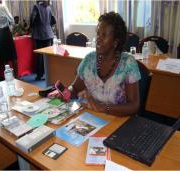From ICT4Ed to ICT4Ag: The Potential of EasySMS Mobile App!
EasySMS mobile app intends to enable illiterate people to “read” SMS on Windows Phone 7; understand the meaning of each word of the SMS; and write SMS using icons with sound support and SMS recomposition from previous SMSs.
It is a Windows phone application which empowers illiterate people to read, compose, send text messages to their contacts, and helps managing contacts in an innovative and funny way through text-to-speech solutions.
The design and development of the app is based on the premise that about 800 million illiterate people are excluded from the benefits of text messaging and most of them reside in rural areas in which mobile phone coverage and ownership is growing rapidly and SMS are cheap or even free. Using a touch screen with simple icons, illiterate users may be able to use their mobile device to navigate through text messages, highlight words from incoming messages, listen to them, and then add them to new messages.
Considering the huge current market size of the users of the application, the developers are very ambitious, optimistic, and believe that their work will lead to the creation of more tools to help illiterate people gain access to information and technology.
Below is the preview of the app:
Illiteracy and Smallholder Farming
A major challenge, I believe, facing the ICTs for Agricultural Development Sector in most developing nations is the high illiteracy levels among the smallholder farmers. As a result, the success of this app will be a success to the ICT4Ag community. It is a laudable initiative which is still at the teething stage and needs a lot of support for improvement.
Several discussions, forums, and debates have been taking place over the years to find alternative models to delivering agricultural information to farmers in the developing nations who cannot read or write. At the same time, with the unprecedented growth of mobile phone among these same group of people, it is a great move to take advantage of the technology. The dominant mode at the moment seems to be SMS or text messaging with its two main limitations – the illiteracy barrier and the amount of information that can be transmitted at a time. EasySMS may be able to reduce the former while the latter still stands.
Designing for Today or Tomorrow?
But my question (as derived from the title of this blog) is – what is our priority? To sustainably address the illiteracy problem by educating our rural folks now, so that they can easily access agricultural information tomorrow or to continue investing in applications that help address the challenge of today’s illiterate farmer in accessing the right information? In other words, how can we modify our ICT4Education programs for long term solutions to the illiteracy problem in the rural farming communities in order to impact ICT4Agriculture programs?
I believe it is time for the ICT4Ed and ICT4Ag communities to begin sharing notes. In order for ICT4Ag applications and projects to have tangible impact on the rural farmers, they must get the basic education necessary to use these apps. While the EasySMS app takes an interesting approach that could eventually create a new breed of “literate” rural folks through the use of these visuals (computer icons) and voice support, we should not forget to catch the future literate farmers while they are young. In doing so, we will be on the path of tackling the information barrier through both short term and long term approaches.







































